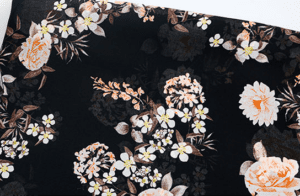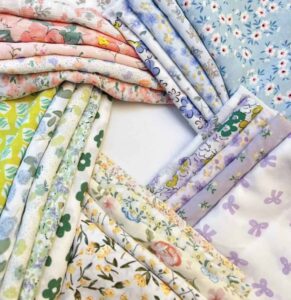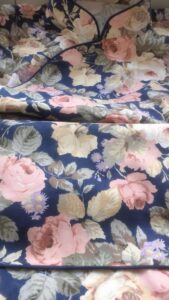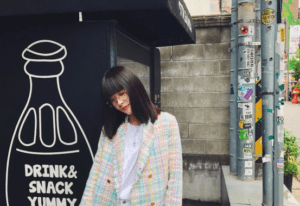Introduction
Digital printing is a very popular printing technology today, breaking through the technical limitations of the traditional printing and dyeing industry and combining digital technology with traditional printing and dyeing technology to become a ‘textile printing technology revolution’. As digital printing technology continues to develop and improve, it is receiving rapidly increasing attention from all sectors, although the printing technology in the dyeing industry has made a huge breakthrough and stimulated the formation of a new consumer market. However, the technology is relatively homogeneous and cheap, which to a certain extent limits its application and expansion in terms of artistic expression. At the same time, the culturally rich, healthy and environmentally friendly “tie-dye” technique is becoming increasingly popular. Tie-dyeing is a traditional hand-printing and dyeing technique with a rich cultural connotation and a long history of development in China. The General Office of the Central Committee of the Communist Party of China and the General Office of the State Council have issued the Opinions on Implementing the Project of Inheritance and Development of Excellent Chinese Traditional Culture, which insists on the principle of preserving traditional culture, rescuing it first, using it rationally and strengthening management. The development and popularity of the traditional tie-dye technique in China is inevitable. In addition to this, under the sustainable development strategy of China, the use of vegetable dyes, which are environmentally friendly, has brought the tie-dyeing process to a new level of popularity, but the tie-dyeing process has many problems of shape and colour that cannot be well controlled.
To a certain extent, the development of tie-dyeing technology is limited. Therefore, in order to meet modern people’s needs for personalisation and cultural connotation, the two technologies are effectively combined so that the visual and cultural connotations are perfectly integrated into the fabric, and the form and level of the fabric will be more enriched, thus widening the market space.
Advantages and disadvantages of digital printing and traditional tie-dye process
Advantages and disadvantages of digital printing
With the development of the times and the continuous transformation of economic forms, individual and convenient operation has become the mainstream of the times, and the emergence of digital printing technology, while increasing the connotation and added value of the print itself, has greatly shortened the time, breaking the constraints of production scale and product timeliness issues. As a high-tech printing process that has emerged in recent years, digital printing is not only rich in colour, with extremely smooth printing levels and a very smooth and natural transition, but also has a photographic tone that can be realistically expressed even when the complexity and fineness of the pattern is high.
However, there are still many problems with the development of the digital printing industry. Take Shengze Town in Wujiang District, Suzhou, for example, which has a textile industry with more than 2,600 textile manufacturing enterprises, and digital printing is an important part of the textile finishing process. In addition to this, there is currently no specialised training for digital printers in China, resulting in a low level of staff, low quality and low efficiency. Furthermore, digital printing only has a flat printing effect, with a single, slightly inexpensive pattern, and there are a large number of digital printing products on the market with average print quality and ordinary designs without cultural heritage. Even the low-end market can easily imitate the print designs of high-end brands, leading to a serious proliferation of inferior products and imitations on the market. These phenomena have, to some extent, restricted the artistic mood of designers and seriously hindered the application and expansion of digital printing in terms of artistic connotations.
Advantages and disadvantages of the traditional tie-dye process
Tie-dyeing is one of the traditional folk dyeing techniques and is mainly based on the natural dye indigo, which gives the fabric a more natural and softer colour that does not fade easily, is environmentally friendly and is beneficial to the human body. The number of overlapping layers of fabric, the number of times and the duration of the dyeing process, and even the weather can affect the final halo effect. In addition, the folding and binding process of tie-dyeing creates many natural folds, and these folds and the relief they bring become a unique texture language, greatly enriching the expressive layers and language of flat fabrics.
The technique of tie-dyeing has not been flawless, however, as in the case of Dali Zhoucheng, the home of Bai tie-dyeing in Yunnan, which was recorded as early as the Han Dynasty and has flourished ever since. However, as times change, and in the face of the impact of modern science and technology, the high cost, time and technical content of the original vegetable dyes used in tie-dye techniques are revealed. In addition, the tie-dyeing process faces other challenges that have not yet been solved, such as the randomness of the patterns, the tendency of tie-dyeing to produce inferior or substandard products compared to other printing and dyeing techniques, and the fact that the patterns cannot be reproduced within a certain proportion. In addition, the colour of tie-dye products is relatively homogeneous and cannot be as rich as “digital printing”.

Fig. 1 Texture effect of the tie-dye process on fabric

Fig. 2 Combination of tie-dye and digital printing on garments

Fig. 3 Combination of tie-dye and digital printing in fabric design

Fig. 4 Combination of tie-dye and digital printing on garments
The colour requirements of the tied-dye process are also fragmented. The patterns formed by tie-dyeing are also fragmented, as shown in Figure 1, and the patterns formed by tie-dyeing do not limit the contours and shapes of the dyeing range, and are full of uncertainty and randomness, making it difficult to achieve strong modelling requirements. The above problems have limited the expansion of the tie-dye process in the market to a certain extent, and it is therefore a valuable design idea to explore the outstanding features of the process and to find innovative combinations to compensate for its shortcomings.
Digital printing and traditional tie-dye process combination
The necessity of organic combination of digital printing and traditional tie-dye process
Although these techniques can enrich the visual effect, they are also more difficult to produce manually, which limits its mass production. Nowadays, as science and technology are developing at a rapid pace, traditional Chinese culture is constantly under the influence of foreign cultures, resulting in the loss of much of the traditional culture, and it is a great pity that such an excellent traditional folk craft as tie-dyeing has not been passed on and developed. The traditional tie-dyeing process, with its unique charm and artistic value, has had a profound influence throughout the country and the world, but due to the many constraints of manual production, the fabric is susceptible to fading and there is a great deal of unpredictability in the design of the patterns, so there is a need to develop a new direction for the tie-dyeing process. As science and technology continue to develop, modern techniques need to be combined with them in order to continue to guarantee the quality and artistic appeal of the dyed fabric and to increase the efficiency of the dyeing process.
Since the 21st century, more and more designers have been using tie-dye techniques to express themselves creatively in their products, and with the aesthetic demands of the new era, the tie-dye process has become more and more modern and in line with the aesthetic needs of the times. The print market has long been dominated by monotone printing. Therefore, combining the advantages of digital printing in terms of rich colours and low prices with the strong sense of form and cultural heritage of the tie-dye process can complement each other and create a harmonious visual effect, as well as creating a clear emphasis on the main focus[9].
The process way and significance of the organic combination of digital printing and traditional tie-dye process
Print first and then dye: as the tie-dye pattern is a unique texture effect due to its anti-dye characteristics, it can be used to print the digital print on the textile fabric first according to this characteristic, as shown in Figure 2, the T-shirt with good digital print will be tie-dyed, as the pattern produced by the digital print has a certain “hydrophobic” effect. “This is the most crucial “anti-dye” effect in tie-dyeing, so that the tie-dyeing solution does not damage the shape and pattern of the digital print and the two processes are combined to produce a new visual effect. This method is so easy to use that one can even put the product containing the digital print directly into the tie-dye dye at home, making it a great experience.
Dye first, print later: the product is first dyed by using the tie-dye process, and then digital printing is used to print the pattern on the fabric after the tie-dye effect has been formed, as shown in Figure 3. The principle of this combination is the same as digital printing on ordinary fabrics, only the substrate is changed from ordinary fabrics to tie-dye fabrics with cultural connotations. This strengthens the layering, weight and colour richness of the pattern and makes up for the respective shortcomings of the tie-dye and digital printing processes.
This combination of design can be described as an ingenious combination of ‘machine and man’, where a digital printing pattern can be machine-made and fixed on a tie-dye pattern that cannot be predetermined well, thus creating an organic combination of random texture and fixed pattern to meet the needs of a wide range of people. This combination of artificial beauty and machine beauty is a product of profound value in the current Internet era, and in the context of China’s ever-increasing requirements for Made in China, this combination of humanity and machine is a reflection of the great wisdom of the Chinese working people in the trend of the times, and a good communication and integration of the excellent traditional culture of the Chinese nation with modern culture.
Practical application of organic combination of digital printing and traditional tie-dye process
1. Print before dye – application in clothing
Figure 4 shows the combination of digital printing and tie-dyeing in a garment. The T-shirt is then tied and dyed in a triangular pattern with a triangular fold. The T-shirt is an organic combination of traditional tie-dyeing techniques and digital printing, creating a new visual effect that is refreshing to the consumer.

Fig. 5 Combination of tie-dye and digital printing on home textiles

Fig. 6 Combination of tie-dye and digital printing in fabric design
2. Printing before dyeing – application in home textiles
Figure 5 shows the combination of digital printing and the tie-dye process in a home textile application. The pillow is made from a combination of digital printing on plain fabric and a tie-dye process. The white part of the pillow is printed by digital printing and the remaining part is the original fabric without any treatment.
Due to the nature of tie-dye, the design texture of each product is unique and has a strong handcrafted value and cultural connotation, while the reproducibility of digital spray painting has greatly improved the production efficiency of the product, not only to meet the market demand for large quantities, but each product will be unique due to the different texture of tie-dye. monotonous and cheap”.
3. Dyeing before printing – application in fabric design
Figure 6 shows the combination of digital printing and tie-dyeing in fabric design, using the principle of digital printing before dyeing. As we can see from recent trends, the innovative design of fabrics, i.e. the transformation of basic fabrics by means of design again, gives new impressions and connotations to traditional fabrics, reshapes the visual and tactile effects of fabrics and further expands their expressive power[11]. The combination process is simple and effective, not only in line with industrial production, but also allows people to work with their own hands at home, allowing customers to ‘create’ their own products. The
(iv) Development prospects of the organic combination of digital printing and traditional tie-dye process
At present, tie-dye crafts and digital printing are generally in their own way in the market, and their respective drawbacks have seriously hindered their rapid development in today’s internet era. This is a new market direction for both tie-dye and digital printing. This will not only give designers new design ideas, but will also give listed companies a degree of production reference. In China’s pursuit of environmental protection and the Made in China 2025 environment, this combination is in line with our national conditions and the trend of the times, as well as the inevitable trend of people’s increasingly rich material and cultural needs and spiritual and cultural needs, so this innovative ‘combination’ has a wide range of development prospects and has a good innovative reference This innovative ‘combination’ has a broad development prospect and is a good reference for innovation, which can promote the continuous development of cultural and creative products.
Concluding
The combination of tie-dye craftsmanship and digital printing is undoubtedly a product of the combination of “humanistic spirit” and “contemporary development”. In today’s internet era, more and more products are required to be given a “cultural connotation” and “spiritual connotation”, and more and more automated industries are not
The transition to a more “human” society is taking place. The demand for ‘humanisation’ is increasing, and products are no longer just about practical value, but more importantly about ‘experiential value’ and ‘cultural value’. The combination of tie-dye handicrafts and digital printing has therefore played a very positive role in the heritage of traditional craftsmanship in China, where the revival and inheritance of traditional culture is now required.
























